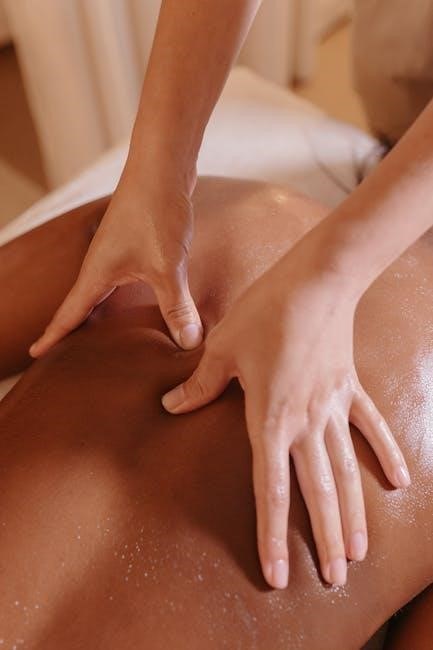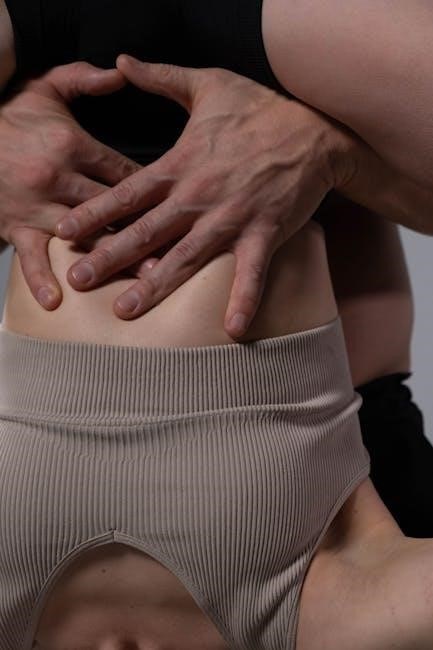Spondylolisthesis involves the anterior slippage of a vertebra, often at L4-L5 or L5-S1, leading to pain and potential neurological symptoms. It is graded based on the degree of slippage, with higher grades indicating greater displacement. This condition can significantly impact daily activities and athletic performance, necessitating a structured physical therapy protocol to manage symptoms, enhance spinal stability, and promote functional recovery.
1.1 Definition and Overview of Spondylolisthesis
Spondylolisthesis is a condition characterized by the anterior slippage of a vertebra relative to the one below it, most commonly occurring at the L4-L5 or L5-S1 levels. It is graded from mild (I) to severe (IV) based on the degree of displacement. This condition can lead to spinal stenosis, nerve compression, or instability, often causing low back pain and limiting functional activities. Early diagnosis and appropriate management are crucial for optimal outcomes.
1.2 Importance of Physical Therapy in Managing Spondylolisthesis
Physical therapy plays a pivotal role in managing spondylolisthesis by addressing pain, improving spinal stability, and restoring functional movement. A structured protocol focusing on core strengthening, flexibility, and proper posture helps prevent further slippage and enhances quality of life. It also enables patients to safely return to daily activities or sports, making it a cornerstone of conservative management for this condition.

Assessment and Diagnosis of Spondylolisthesis
A comprehensive clinical evaluation, including patient history, physical examination, and imaging modalities like X-rays or MRIs, is essential for diagnosing spondylolisthesis and guiding therapy.
2.1 Clinical Evaluation and History Taking
A thorough clinical evaluation and detailed history taking are crucial for diagnosing spondylolisthesis. Key components include assessing pain patterns, activity-related symptoms, and mechanical factors. The physical exam focuses on posture, range of motion, and palpation for tenderness. Specific tests, such as the slump test or prone instep test, may be used to identify nerve involvement or instability. This process guides the development of a tailored physical therapy protocol.
2.2 Imaging Modalities for Diagnosis
Imaging modalities such as X-rays, MRIs, and CT scans are essential for diagnosing spondylolisthesis. X-rays provide initial confirmation of vertebral slippage, while MRIs offer detailed visualization of soft tissues and nerve compression. CT scans are useful for assessing bony structures and pars defects. These imaging tools help confirm the diagnosis, evaluate the degree of slippage, and guide appropriate physical therapy or surgical interventions.

Phases of Physical Therapy Protocol
The physical therapy protocol for spondylolisthesis is divided into three phases: acute (pain management), subacute (strengthening), and advanced (functional restoration). Each phase addresses pain, mobility, and strength progressively to ensure recovery and return to activity.
3.1 Acute Phase: Pain Management and Stabilization
The acute phase focuses on reducing pain and stabilizing the spine. Interventions include rest, ice therapy, and temporary bracing to limit movement. Gentle exercises like pelvic tilts and core activations are introduced to improve stability without exacerbating symptoms. The goal is to alleviate discomfort and create a foundation for progressive strengthening in subsequent phases, ensuring pain-free activities and minimizing further injury risk.
3.2 Subacute Phase: Progressive Strengthening and Mobility
In the subacute phase, the focus shifts to enhancing strength and mobility while maintaining spinal stability. Exercises such as bridging, bird-dog, and gentle stretching for hamstrings and hip flexors are introduced. These activities improve lumbar stability, posture, and range of motion. Progression criteria include pain-free static exercises, neutral spine maintenance, and ability to perform dynamic mobilizations. The goal is to build a strong foundation for functional activities and sports participation.

3.3 Advanced Phase: Functional Restoration and Return to Activity
The advanced phase focuses on restoring functional abilities and facilitating a safe return to sport or daily activities. Dynamic exercises, such as single-leg deadlifts and rotational movements, are emphasized to enhance proprioception and strength. Sport-specific drills and plyometric exercises are gradually introduced to mimic real-world movements. The goal is to achieve full functional recovery, ensuring the patient can perform without pain or instability, ready for unrestricted activity participation.

Conservative Management Strategies
Conservative management strategies for spondylolisthesis include rest, bracing, and activity modification to alleviate symptoms and promote healing. Medications and patient education are also integral to this approach.
4.1 Rest, Bracing, and Activity Modification
Rest and bracing are often recommended to reduce pain and prevent further slippage. Activity modification involves avoiding movements that exacerbate symptoms, such as heavy lifting or hyperextension. Braces, like Boston braces, may be prescribed to provide spinal support and stability. Lifestyle adjustments, including avoiding heavy backpacks and sleeping on the stomach, are also essential to manage the condition effectively.
4.2 Medications and Adjunctive Therapies
Medications such as NSAIDs are prescribed to manage pain and inflammation. Adjunctive therapies like TENS units and ice/heat therapy can help alleviate discomfort. Calcium and vitamin D supplements are recommended to support bone health. Pain-relieving medications should be used as directed by a physician, while therapies like TENS provide additional relief without the need for medication.
4.3 Patient Education and Lifestyle Modifications
Patient education is crucial for managing spondylolisthesis. Emphasize activity modification, proper posture, and avoidance of aggravating movements. Lifestyle changes include maintaining a healthy weight, smoking cessation, and a calcium-rich diet with vitamin D. Educating patients on proper lifting techniques and ergonomics can prevent further injury. Regular follow-ups and adherence to the therapy plan are essential for long-term spinal health and functional improvement.

Rehabilitation Exercises and Progression
Rehabilitation focuses on core strength, lumbar stabilization, and pelvic tilt exercises to enhance spinal stability. Progression includes pain-free static exercises, maintaining a neutral spine during movements, and improving flexibility for functional recovery.
5.1 Core and Lumbar Stabilization Exercises
Core and lumbar stabilization exercises are foundational in managing spondylolisthesis. These exercises strengthen abdominal and back muscles, enhancing spinal stability. Pelvic tilts and bridging improve lumbar mobility and strength. Neutral spine positioning is emphasized to reduce strain on the lower back. Progression includes dynamic exercises like bird-dog and Superman variations, focusing on maintaining proper alignment during movements to promote functional recovery and minimize pain.
5.2 Flexibility and Mobility Exercises
Flexibility and mobility exercises are crucial for reducing muscle tightness and improving joint range of motion in spondylolisthesis patients. Hamstring and hip flexor stretches are often recommended to alleviate tension in the lower back. Gentle cat-camel stretches and pelvic tilts can enhance spinal flexibility while maintaining a neutral spine position. These exercises help reduce pain and improve posture, promoting overall spinal stabilization and functional movement patterns.
5.3 Proprioceptive and Functional Training
Proprioceptive and functional training focuses on improving balance, coordination, and spinal awareness in spondylolisthesis patients. Exercises such as single-leg stands, wobble board activities, and dynamic movements enhance neuromuscular control. These drills help restore proper movement patterns, reducing the risk of further injury. Functional training also incorporates sport-specific movements to prepare patients for return to activity, ensuring a smooth transition to daily or athletic demands with improved spinal stability and reduced pain.

Return to Sport or Activity
Return to sport or activity requires careful progression, ensuring pain-free movements, maintained spinal stability, and sufficient strength. A structured protocol helps athletes safely transition back to their activities.
6.1 Criteria for Safe Return to Sport
The criteria for safe return to sport include pain-free static and dynamic exercises, maintained neutral spine during movements, and adequate core strength. Progression requires full pain-free range of motion, normal hip and thoracic mobility, and improved proprioception. Sport-specific rehabilitation must be completed, and the athlete should demonstrate functional stability and strength. Medical clearance is often necessary to ensure readiness for unrestricted participation.

6.2 Sport-Specific Rehabilitation and Exercise Progression
Sport-specific rehabilitation involves tailored exercises to address the athlete’s movement patterns and demands. Progression includes dynamic stability drills, functional movements like lunges, and sport-specific rotations. Core and lower extremity strengthening are emphasized to enhance performance and reduce injury risk. Exercises are adapted based on the sport, ensuring proper technique and spinal alignment. The goal is to restore optimal function and safely return to competitive activities.

Manual Therapy and Adjunctive Treatments
Manual therapy, including joint mobilizations and soft tissue techniques, enhances spinal mobility and reduces stiffness. Adjunctive treatments like TENS, heat, and ice support pain management and inflammation reduction.
7.1 Thoracic and Hip Mobilization Techniques
Thoracic and hip mobilizations are essential in addressing spinal stiffness and improving range of motion. Techniques such as spinal manipulative therapy and joint mobilizations target the thoracic spine and hips, reducing mechanical stress on the lumbar spine. These methods enhance flexibility, promote proper movement patterns, and alleviate discomfort associated with spondylolisthesis, complementing other therapeutic interventions effectively.
7.2 Use of TENS, Heat, and Ice Therapy
Transcutaneous Electrical Nerve Stimulation (TENS) helps manage acute pain by disrupting pain signals to the brain. Heat therapy, such as warm compresses, relaxes muscles and improves blood flow, reducing stiffness. Ice therapy decreases inflammation and numbs the area, providing relief in acute phases. These modalities are often combined with exercises to enhance comfort and support the physical therapy protocol for spondylolisthesis management effectively.
Spondylolisthesis management requires a comprehensive approach, emphasizing physical therapy. Evidence-based protocols, such as those by Robert Gunzburg and Marek Szpalski, guide effective treatment. Adherence to these guidelines ensures optimal outcomes.
8.1 Summary of Key Takeaways
Spondylolisthesis management emphasizes a conservative approach, focusing on physical therapy to enhance spinal stability and reduce pain. Core strengthening, flexibility exercises, and functional training are integral to rehabilitation. Criteria for returning to activity include pain-free movements and improved strength. Manual therapy, such as thoracic and hip mobilization, complements exercises. Use of TENS, heat, and ice therapy aids in pain management, while bracing and activity modification support recovery. Adherence to evidence-based protocols ensures optimal outcomes and prevents progression of the condition.
8.2 Recommended Reading and Resources
Key resources include studies by Gunzburg and Szpalski (2006) on spondylolisthesis management and clinical guidelines from the North American Spine Society. The Journal of Orthopaedic & Sports Physical Therapy offers evidence-based exercises. A comprehensive PDF guide from SOSMed.org details rehabilitation protocols, while clinical trials on lumbar stabilization are highlighted in Spine Journal. These resources provide invaluable insights for therapists and patients.
